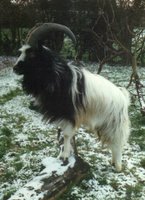
Mystery surrounds origins of Bagot goat
“The little known history of the Bagot goat is interlaced with images of knights on horseback, kings and coats of arms. A story spanning 800 years where fact, legend and folklore are closely intertwined.
When Richard the Lionheart returned from the Holy Land in 1194, Prince John was Regent of England and Robin Hood championed the poor from Sherwood Forest – the legend is well known. But what is unknown is that when Richard returned from the crusades it is thought he brought back a few black-headed goats from the Rhone valley of Switzerland.
Two hundred years later in 1380, a young Richard 11 presented a herd of black and white goats to Sir John Bagot of Blithfield Hall in Staffordshire.
These were released into Bagot Park, 800 acres of woodland on the edge of the great Needlewood Forest. This was their home for 600 years.
But in 1939, Blithfield Estate was bought with the intention of drowning the land to create a massive reservoir.
The following year the War Agriculture Executive issued an extermination order which Lord Bagot disputed. The goats received a reprieve but in 1953 most of the land was flooded and the remaining land cleared for farming.
Of the hundreds of goats which had freely roamed the woodlands only 20 were kept. These were brought to the Hall by Lady Bagot.
The goats now had to live in a walled garden and small paddock close to the house. Gone was the forest habitat and with it the goats’ future.
By 1979 only 12 goats survived giving them the dubious distinction of being the rarest of the rare breeds of the British Rare Breeds survival Trust.
Nancy, Lady Bagot had no option but to entrust their survival to the RBST.”
I wrote this story for The Goat Farmer Magazine (NZ) June 2000, I now discover that the legend in which Richard the Lionheart plays a central role, has been questioned and partially disproved.
It appears that the goats did arrive at Bagot Park in the late 1300s as a gift from Richard 11. But the question remains, where did the goats come from?
One supposition is that in 1386 when John of Gaunt set sail, he was joined in his crusade by the King of Portugal. But it was not long before the English army started to waste and Sir John Bagot, returned to England.
Recently, DNA teats conducted on the goats showlinks, however slight, with a Portuguese and a Pyrenean goat.
It also shows that there are no links to the Swiss Schwartzhal goat.
However, it will take further investigation to prove this and until then, this ancient breed remains veiled in the mists of time.
And I am sure, however, that no-one will dispute the fact that the Bagot goat is a noble beast with a long and noble heritage.
My thanks to Peter Evans for the photograph and to the Bagot Goat Breed Society's website for this updated historical information.
No comments:
Post a Comment